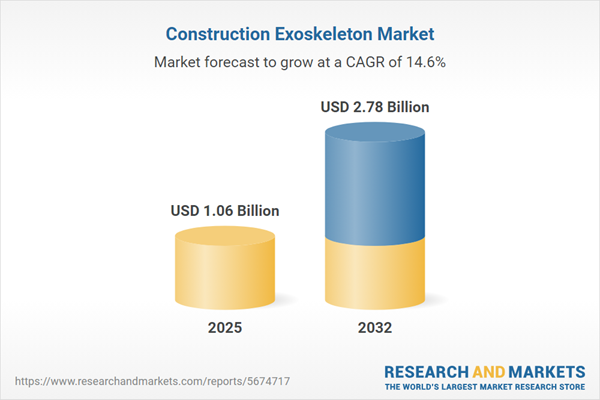Speak directly to the analyst to clarify any post sales queries you may have.
The construction exoskeleton market is rapidly transforming jobsite practices, providing senior leaders with innovative solutions to workforce challenges and operational risk management as wearable robotics become a mainstay.
Market Snapshot: Construction Exoskeleton Market Analysis
The global construction exoskeleton market is projected to advance from USD 932.75 million in 2024 to USD 1.06 billion in 2025, then reach USD 2.78 billion by 2032. This expansion signals a clear movement toward integrating wearable robotics into core site operations, with organizations leveraging these systems to address labor shortages and ensure on-site safety compliance. The trend reflects a deliberate industry-wide transition, as manufacturers and stakeholders introduce both active and passive devices that align with evolving construction methods. Regulatory adjustments and heightened needs for risk mitigation are facilitating broader adoption, allowing new exoskeleton technologies to redefine operational expectations and build more resilient construction environments.
Scope & Segmentation of the Construction Exoskeleton Market
- Product Types: Active and passive exoskeletons deliver adaptive physical support throughout various construction phases, aiding in lifting, endurance, and repetitive tasks.
- Body Focus: Whole-body, upper-body, and lower-body models optimize support for specialized activities and repetitive actions, reducing physical strain in diverse settings.
- Applications: Technologies are used for manual material handling, repetitive movement reduction, precision operations, and overhead work, enabling greater workflow efficiency and safety.
- Power Sources: Exoskeletons feature electric, hydraulic, and spring-powered mechanisms, making them compatible with a variety of site infrastructures and operational demands.
- Distribution Channels: Sourcing is possible through direct manufacturer engagement, specialized distributor networks, or digital procurement platforms, permitting flexibility in acquisition and deployment.
- Geographic Regions: The market encompasses the Americas, Europe, Middle East, Africa, and Asia-Pacific, reflecting distinct regulatory settings and operational landscapes.
- Featured Companies: Prominent providers include Ekso Bionics Holdings, Sarcos Technology and Robotics, ReWalk Robotics, Ottobock, Levitate Technologies, Lockheed Martin, German Bionic Systems, RB3D, Hyundai Motor Company, and ExoAtlet LLC.
Key Takeaways for Senior Decision-Makers
- Continuous ergonomic tracking helps detect worker strain early and empowers safety compliance across all phases of construction projects.
- Deploying wearable robotics mitigates fatigue, directly supporting workforce retention and the ability to deliver on complex design requirements.
- Selecting active or passive exoskeletons by matching project-specific risks allows for measured, cost-efficient investments.
- Partnerships between technology vendors, contractors, and supply chain stakeholders smooth the path to effective workforce integration and strong adoption rates.
- Regional adaptation—factoring in local regulations and environmental conditions—supports long-term uptake and operational consistency in each market.
United States Tariff Impact on Exoskeleton Components
As upcoming U.S. tariffs on imported exoskeleton components emerge in 2025, procurement strategies and supplier diversification are receiving renewed focus. Organizations are exploring sourcing from regional vendors and favoring modular exoskeleton designs to ease upgrades and maintain regulatory adherence. Agreements are being revisited and adjusted to preempt supply interruptions and reinforce compliance as market dynamics continue to evolve.
Methodology & Data Sources
This market study synthesizes expert insights, direct site observations, and technical scrutiny of construction exoskeleton deployments. The analysis leverages groundwork validation from practitioners and an ongoing examination of regulations guiding the deployment of exoskeleton technologies in the construction sector.
Why This Construction Exoskeleton Market Report Matters
- Equips leadership teams to align safety strategies with the demands of a transforming construction workforce.
- Clarifies the influence of regional trends and segment advances, supporting confident risk assessment and future-oriented business strategy.
- Guides robust procurement policies and supply chain decisions as organizations navigate evolving regulatory and operational standards.
Conclusion
Integrating exoskeletons into construction operations is reshaping safety and operational benchmarks. Informed by timely market intelligence, decision-makers can adapt confidently, ensuring workforce resilience and sustained operational efficiency in an evolving industry landscape.
Additional Product Information:
- Purchase of this report includes 1 year online access with quarterly updates.
- This report can be updated on request. Please contact our Customer Experience team using the Ask a Question widget on our website.
Table of Contents
3. Executive Summary
4. Market Overview
7. Cumulative Impact of Artificial Intelligence 2025
Companies Mentioned
The companies profiled in this Construction Exoskeleton market report include:- Ekso Bionics Holdings, Inc.
- Sarcos Technology and Robotics Corporation
- ReWalk Robotics Ltd.
- Ottobock SE & Co. KGaA
- Levitate Technologies, Inc.
- Lockheed Martin Corporation
- German Bionic Systems GmbH
- RB3D S.A.S.
- Hyundai Motor Company
- ExoAtlet LLC
Table Information
| Report Attribute | Details |
|---|---|
| No. of Pages | 184 |
| Published | November 2025 |
| Forecast Period | 2025 - 2032 |
| Estimated Market Value ( USD | $ 1.06 Billion |
| Forecasted Market Value ( USD | $ 2.78 Billion |
| Compound Annual Growth Rate | 14.6% |
| Regions Covered | Global |
| No. of Companies Mentioned | 11 |









